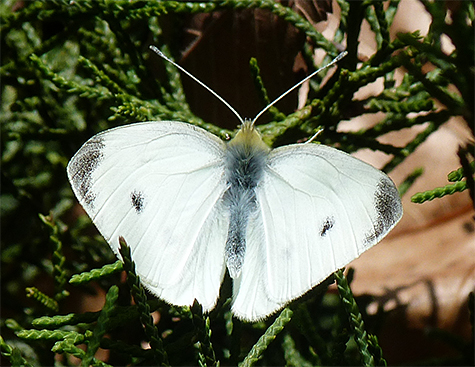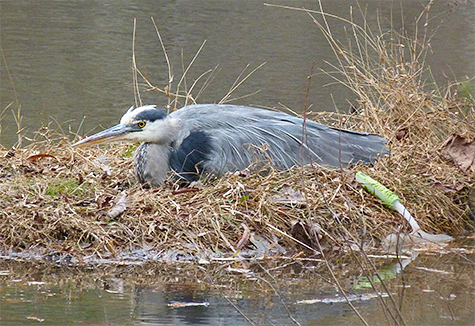
I was standing at the Red Wolf Overlook talking with guests, and admiring the wolves who were actively moving about the enclosure, when I spotted a white butterfly wafting past and over the heads of the assembled crowd. It alighted in a red cedar. I walked over to take a few photos.
I knew it was a cabbage white when I first saw the insect. The only other white butterflies of its size in our area are the white forms of the clouded or orange sulphurs. They’re actually off white and have more black on the upper surface of the wings than cabbage whites.
Cabbage whites are not from this continent. They are native to Europe, Asia, and North Africa. They began showing up in Quebec in 1860 and quickly spread throughout the land. You’re likely to see a cabbage white wherever you travel in North America.
Cabbage whites, or their caterpillars, eat the leaves of crucifers, plants in a family that includes cabbages and mustards.
Being a non-native species, and seemingly everywhere, I thought it odd when I saw a request on Facebook a few months ago for information on sightings of this butterfly in Florida. It seems the butterfly is declining in numbers. And, as I looked up more local info on the butterfly I found this on the Butterflies of North Carolina web site, “Numbers in the past few years have declined sharply nearly statewide, owing to loss of habitat to development and abandonment, drought, and perhaps other factors.”
Apparently, the cabbage white is not alone in its decline, a little further down on the web page was this, “With the continued loss of agricultural fields to development, numbers of Cabbage White, Checkered White, Clouded Sulphur, and Orange Sulphur, among several other species, continue to plummet in NC.”
Is the cabbage white’s decline a good thing or a bad thing? If you like butterflies you may think it a bad thing. If you like only native species you might think it a good thing. But, I must add that the population of all of those butterflies, the sulphurs and the whites, were probably much smaller before the cultivation of the agricultural fields that they are attracted to. The numbers of crop eating butterflies ballooned as settlers spread across the land and fields were planted with what the butterflies found to be easy pickings, whole fields full of the same plant, acres and acres of alfalfa, mustard, or cabbage to lay eggs on and their caterpillars to munch on.
——-
On a cold damp morning this week I saw our resident Great Blue Heron stretched out on a small island just off the boardwalk leading into the wetlands.

I’ve seen this, or another, heron in the same spot before. What’s interesting here is the object next to the heron. If you’ve been to the Main Wetlands Overlook in Explore the Wild you may recognize this object. It’s a squeegee from the Stream Table on the overlook.
It’s not uncommon for the squeegees to end up in the Wetlands’ water. I’ve fished more than a few out of the water. Various types of squeegees have been used over the years, most sink to the bottom when tossed into the water. This most recent variety seems to semi-float. But, even if it did somehow float over to the island it would have had to have done so when the water was much higher than it is in the photo for it to come to rest where it is. I don’t recall that island being topped by water recently. Could something have dragged it up onto the island? Why?
That’s a mystery that may not be solved. It looks though, that I may have to go over to the island to retrieve the squeegee, just another day in the Wetlands.